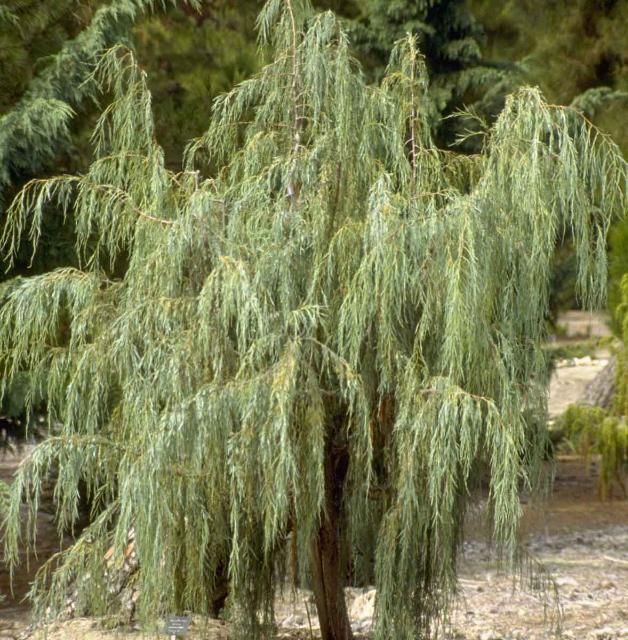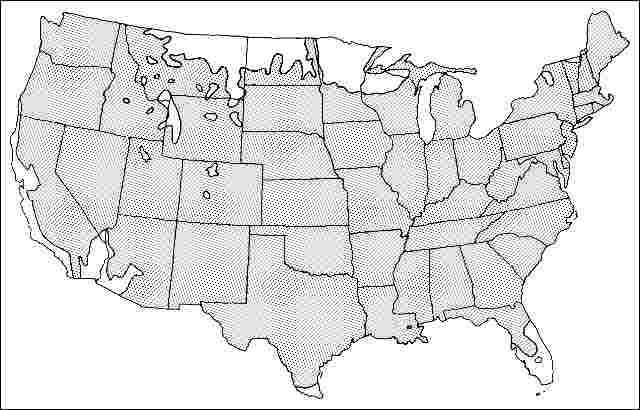Introduction
Juniperus scopulorum is a native plant that can be found in the western United States. This cultivar grows to about 25 to 30 feet tall with an equal spread. Arching branches grow up and out from the trunk bearing foliage which hangs almost like weeping willow. The tree is very striking and will provoke comments from neighbors. This and other weeping trees look very nice planted close to water, but be sure to keep the root zone on the dry side. It is similar to other junipers in that it requires a full sun exposure and will tolerate dry and droughty soils. It is useful as a privacy screen or makes a wonderful specimen. This juniper is difficult to grow in the south due to disease problems, but might be accomplished in a well-drained, dry site.

Credit: Ed Gilman, UF/IFAS
General Information
Scientific name: Juniperus scopulorum
Common name(s): 'Tolleson's Green Weeping' Rocky Mountain Juniper
Family: Cupressaceae
USDA hardiness zones: 4A through 9A (Fig. 2)
Origin: native to North America
Invasive potential: little invasive potential
Uses: specimen; screen; bonsai
Availability: not native to North America

Description
Height: 25 to 30 feet
Spread: 25 to 30 feet
Crown uniformity: irregular
Crown shape: weeping
Crown density: moderate
Growth rate: moderate
Texture: fine
Foliage
Leaf arrangement: opposite/subopposite (Fig. 3)
Leaf type: simple
Leaf margin: entire, terminal spine
Leaf shape: scale-like
Leaf venation: none, or difficult to see
Leaf type and persistence: evergreen, fragrant
Leaf blade length: less than 2 inches
Leaf color: green
Fall color: no color change
Fall characteristic: not showy

Flower
Flower color: unknown
Flower characteristics: not showy
Fruit
Fruit shape: cone, round
Fruit length: less than .5 inch
Fruit covering: fleshy
Fruit color: blue
Fruit characteristics: attracts birds; showy; fruit/leaves not a litter problem
Trunk and Branches
Trunk/bark/branches: branches droop; not showy; typically multi-trunked; thorns
Pruning requirement: needed for strong structure
Breakage: resistant
Current year twig color: brown, gray
Current year twig thickness: thin
Wood specific gravity: unknown
Culture
Light requirement: full sun
Soil tolerances: sand; loam; alkaline; acidic; well-drained
Drought tolerance: high
Aerosol salt tolerance: unknown
Other
Roots: not a problem
Winter interest: no
Outstanding tree: yes
Ozone sensitivity: unknown
Verticillium wilt susceptibility: resistant
Pest resistance: resistant to pests/diseases
Use and Management
There are many other cultivars of this plant available to consumers due to the efforts of nursery operators. Only a small sample of their variability will be presented here. 'Gray Gleam'—silvery gray foliage, pyramidal, slow growing to 15 feet in 30 years; 'Skyrocket'—very narrow columnar growth, bluish green foliage. After the plant reaches about 15 feet tall (after about 10 to 15 years) it is subject to bending of the lateral branches, some to the ground, ruining its form. 'Table Top'—semi-upright, flat-topped growth habit, silvery gray foliage, 5 feet high in 10 years; 'Wichita Blue'—bright blue cast to foliage, pyramidal form.
Pests
Bagworm caterpillars web foliage together to make bags up to two inches long. The insects live in the bags and emerge to feed on the foliage. Use sprays of Bacillus thuringiensis. The insects can also be picked off the plants by hand.
Juniper scale causes yellowed needles, and infected branches fail to produce new growth. The scale is round and at first white, later turning gray or black.
The Juniper webworm webs twigs and needles together, causing them to brown and die. The larva is 1/2-inch-long and is brown with darker stripes. The larvae are often in the densest part of the plant and can go unnoticed.
Mites cause stippled and bronzed foliage.
Diseases
Twig blight causes death and browning of twigs tips. The disease may progress down the stem killing the whole branch. Small lesions may be seen at the base of dead tissue. Prune out dead branch tips.
Three rust diseases seen most often are cedar-apple rust, hawthorn rust, and quince rust. Cedar-apple is the most common. On Juniper the disease forms galls that form orange jelly-like horns in spring. The horns are most likely to form following periods of rainy, warm weather. Spores formed in the horns infect the alternate host. The diseases are more serious on the alternate host than Juniper. A separation of a few hundred yards may help avoid the disease. Prune out the spore horns when seen in the spring.
Junipers are not tolerant of ice coatings. Expect dieback when Junipers are covered with ice for several days. Removing the ice is impractical.